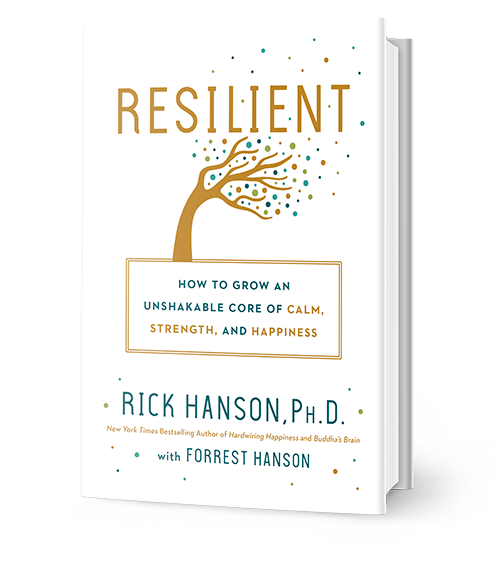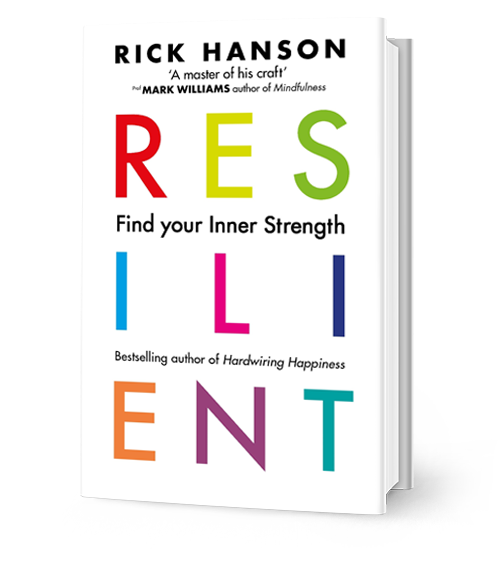07 Mar Feeling Safer
It’s normal to experience fear or helplessness from time to time. Problems arise when these reactions are invasive, chronic, or otherwise impact your wellbeing, relationships, or work. Because the need for safety is so vital, it’s equally vital that we regulate ourselves to meet pain and threats with Calm strength.
My new book Resilient focuses on growing 12 essential inner-strengths for lasting well-being in a changing world, and Calm is one of them.
In the excerpt below, you’ll learn how to feel safer, and have a greater sense of calm.
Fear arises when threats seem bigger than resources.
Sometimes this is actually the case, such as getting an unexpected bill that you don’t have the money to pay. But due to “paper tiger paranoia,” threats often look larger than they really are while resources look smaller than they really are.
Even if you realize that fear plays an irrationally large role in your life, it can still be hard to let go of it. Many people are afraid, in effect, of not being afraid, since that’s when their shields come down. Then they fear that WHAP! something might hurt them.
To be safer, we need to decrease actual threats and increase actual resources. To feel safer, we need to stop inflating threats and start recognizing all our resources. Then we don’t have to be afraid of not being afraid.
Let’s say you’re doing what you can to reduce the actual threats in your life while developing real resources for handling them. Meanwhile, make sure you are seeing threats clearly, appreciating your resources, and feeling as safe as you reasonably can.
Seeing Threats Clearly
Pick one thing that worries you. It could be an illness, finances, or a conflict with another person. It could also be an area of life in which you’re holding back to reduce risks, such as avoiding public speaking or not asking for what you really want in a relationship. You can do this process by reflecting to yourself, journaling, or talking about it with someone, and you can use it with multiple things that worry you.
How Big Is It?
Be specific and concrete about the size of the challenge. In effect, put a fence around the issue rather than letting it be nebulous and overwhelming. For instance, instead of “My health is bad,” how about “I have high blood pressure”? Bound the issue in space and time. What part of your life does it affect – and what is unaffected? When does it happen – and when is it not very relevant?
How Likely Is It?
Perhaps you’re stuck with an ongoing condition, such as a chronic health issue.
But most of the time when we feel anxious, it’s about something bad that might happen: there is a threat of pain, but not pain itself.
For instance, a person might think, “I could get sick” or “If I express anger, no one will want me.” If what you are concerned about is a possibility but not yet a reality, ask yourself: What are the odds, actually? In your past, a certain kind of bad event could indeed have been likely, perhaps because of the people you lived with or knew back then. But today, things are different, and the chances of a bad event are probably much lower.
How Bad Would It Actually Be?
What would you experience if the threat did come true? Let’s say you’re afraid of someone rejecting you if you’re more vulnerable or assertive. OK, suppose the feared event occurs. What would you actually feel if it happened? On a 0-10 scale, with 10 being the absolute worst imaginable, how bad would you feel? And for how long? In the past, similar events could have felt truly horrible, especially during childhood when things are felt more keenly before the nervous system fully matures. But these days, as an adult, you have many more inner shock absorbers.
There’s a good chance that you wouldn’t feel as bad or for as long as you fear you would.
Let the Good News Land
Let all this sink in. It is really, really true. You can believe it. Let yourself feel convinced of it. Using the HEAL steps, open to relief and reassurance about this good news. Take it into yourself, easing and gradually replacing excessive, needless alarm and tension and anxiety.
Resilient: How to Grow an Unshakable Core of Calm, Strength, and Happiness is now available. Get your copy today!




